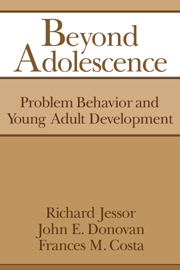Book contents
- Frontmatter
- Contents
- List of tables and figures
- Preface
- Part I The approach
- Part II Young adulthood
- Part III Development and change
- 7 Psychosocial development from adolescence to young adulthood
- 8 Linking proneness to problem behavior in adolescence with involvement in problem behavior in young adulthood
- 9 Involvement in problem behavior in adolescence/youth and outcomes in young adulthood
- Part IV Conclusions
- Name index
- Subject index
8 - Linking proneness to problem behavior in adolescence with involvement in problem behavior in young adulthood
Published online by Cambridge University Press: 07 October 2009
- Frontmatter
- Contents
- List of tables and figures
- Preface
- Part I The approach
- Part II Young adulthood
- Part III Development and change
- 7 Psychosocial development from adolescence to young adulthood
- 8 Linking proneness to problem behavior in adolescence with involvement in problem behavior in young adulthood
- 9 Involvement in problem behavior in adolescence/youth and outcomes in young adulthood
- Part IV Conclusions
- Name index
- Subject index
Summary
A key objective of this longitudinal research effort has been to explore the linkage between problem-behavior proneness in adolescence/ youth and involvement in problem behavior later on in young adulthood. Are the values, attitudes, behaviors, and peer group associations of adolescence/youth influential in shaping later patterns of behavior despite the major changes in life circumstances that inevitably occur? Or does the transition from one life stage to the next entail such discontinuity that little predictability of later problem behavior involvement is possible?
Longitudinal research findings remain somewhat equivocal about the linkage between adolescent characteristics and later, young adult problem behavior. Newcomb and Bentler (1988) found that variation in social conformity in late adolescence is a significant predictor of later drug use, drug–crime involvement, and other criminal activities in young adulthood. Magnusson (1988) has shown a relationship between early adolescent aggressiveness and motor restlessness and later young adult criminality. On the other hand, Temple and Fillmore (1985–86) report little predictability between measures of academic self-concept, family support, and positive and negative peer networks assessed at age 18, and drinking to the point of drunkenness at age 31 (but for another interpretation, see Windle, 1988).
In this chapter, we examine the predictability of young adult problem behavior from psychosocial proneness for problem behavior measured in adolescence/youth. The focal concern is whether those participants in our study who were at greater psychosocial risk (personality risk, perceived environment risk, and behavioral risk) for problem behavior in adolescence/youth are the ones most likely to be involved in problem behavior later on as young adults.
- Type
- Chapter
- Information
- Beyond AdolescenceProblem Behaviour and Young Adult Development, pp. 195 - 250Publisher: Cambridge University PressPrint publication year: 1992



